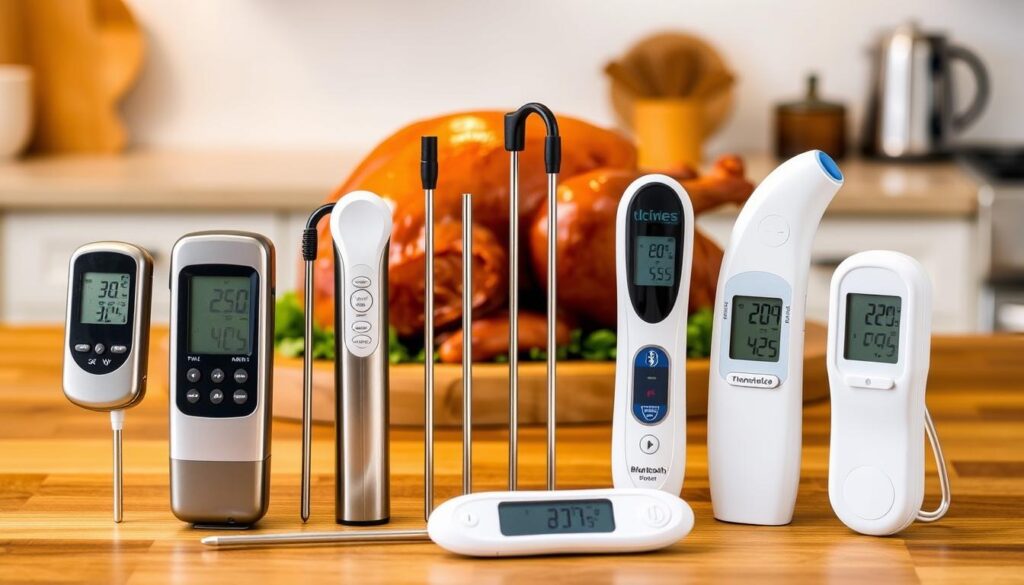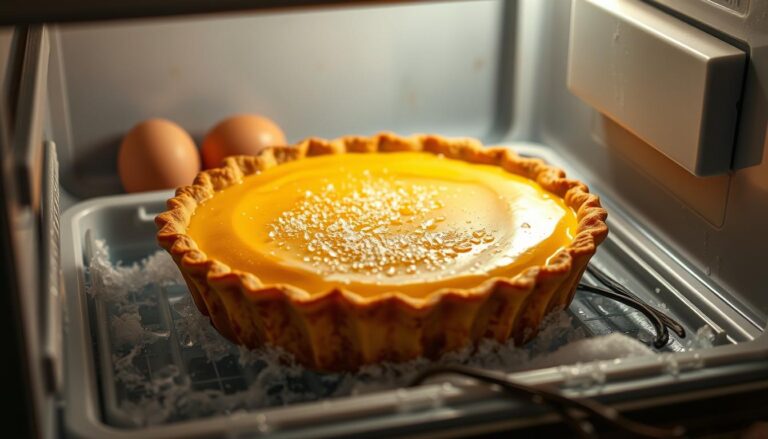Where to Insert Thermometer in Turkey?
Did you know nearly 75% of people undercook their turkey? This is why using a meat thermometer is so important. It makes sure your turkey is safe and perfectly cooked. Knowing where to put the thermometer is key.

For the breast, aim for 165°F (73°C). For the wings and legs, it should be between 175°F – 180°F (79-82°C). This guide will show you the best spots for thermometer placement. It’s all about a delicious and safe Thanksgiving feast.
The Importance of Using a Meat Thermometer
Using a meat thermometer is key for a safe and tasty turkey. It’s mainly to ensure turkey safety, which lowers the chance of getting sick from food. The USDA says turkey must hit an internal temperature of at least 165°F.
A big change has happened, with more people owning food thermometers. In 1998, 49% had one, but by 2010, that number jumped to 70%. This shows how important meat thermometers have become in kitchens today.
Ensuring Food Safety
Food safety depends on getting the temperature right. Turkey that’s not cooked enough can have bad bacteria. So, it’s important to check the turkey’s internal temperature.
Many people use “pop-up” thermometers to know when the turkey is done. But, these aren’t always right. Using a separate thermometer is safer and gives you peace of mind when serving food.
Preventing Overcooking
Using a thermometer correctly helps avoid overcooked turkey. It keeps the meat juicy and full of flavor. Where you put the thermometer is very important.
Putting it in the wrong spot can give you wrong readings. A 25°F change in oven temperature can make the meat 5% drier. Knowing the difference in temperature between the breast and leg helps avoid dry turkey.
Choosing the Right Meat Thermometer
Choosing the right meat thermometer is key to great cooking. The market has many options, making it hard to decide. This guide will help you pick the best meat thermometer types and the benefits of digital instant-read thermometers.
Types of Thermometers
There are different meat thermometers for different cooking needs. The most common types are:
- Analog Thermometers: They offer a classic approach but might not be as precise.
- Digital Instant-Read Thermometers: These are fast, giving quick temperature readings.
- Leave-In Thermometers: They are made for long cooking, staying in the meat as it cooks.
Understanding each type’s unique features helps cooks make better choices. Digital thermometers, like those for turkey, are popular for their accuracy and speed.
Benefits of Digital Instant-Read Thermometers
Digital instant-read thermometers have many advantages. They give fast temperature readings, ensuring your turkey is cooked to 165 degrees Fahrenheit. They are great because:
- They remove guesswork, leading to consistent results.
- They let you check both the breast and thigh areas, perfect for big turkeys.
- They have alarms and presets to avoid undercooking or overcooking.
The ThermoPro TP-20 meat thermometer is an example. It gives quick and accurate readings and has manual controls for custom temperatures. Using a digital instant-read thermometer ensures your turkey is safe and tastes great. This makes for a better dining experience.

| Type of Thermometer | Speed | Accuracy | Convenience |
|---|---|---|---|
| Analog Thermometers | Slow | Moderate | Moderate |
| Digital Instant-Read Thermometers | Fast | High | High |
| Leave-In Thermometers | Moderate | High | Very High |
Where to Insert Thermometer in Turkey?
Knowing where to put the thermometer in a turkey is key for cooking it right. Putting it in the wrong spot can lead to turkey cooking mistakes. This can make the meat undercooked or overcooked. To make sure your turkey is cooked just right, follow these tips and avoid common mistakes.
Recommended Insertion Points
The main places to put the thermometer in a turkey are:
- The thickest part of the turkey breast, ideally at a depth of 10cm to 12cm. Insert the thermometer perpendicularly to measure accurately.
- The inner thigh, where the meat is the thickest.
- The wing, ensures the probe does not touch bone or gristle to maintain accuracy.
To eat the turkey safely, the breast should be 165°F (73°C). The thighs and wings should be between 175°F and 180°F (79°C – 82°C). Placing the thermometer in these spots ensures the turkey is cooked well and safe to eat.
Avoiding Common Mistakes
To get accurate readings, avoid these common mistakes:
- Inserting the thermometer too close to bone, which can give misleading readings.
- Not allowing the probe to envelop the flesh properly; the probe must be surrounded on both sides by meat.
- Repositioning the thermometer if you encounter resistance, indicates possible bone interference.
Experts say to put the thermometer in the turkey for 15 to 20 seconds for accurate results. With an instant-read thermometer, pull the turkey from the oven when the breast hits 160°F. It will cook more and reach 165°F while resting.

| Insertion Point | Recommended Internal Temperature |
|---|---|
| Thickest part of the breast | 165°F (73°C) |
| Inner thigh | 175°F – 180°F (79°C – 82°C) |
| Wing | 175°F – 180°F (79°C – 82°C) |
| Resting turkey | 165°F (73°C) upon resting |
By placing the thermometer correctly and avoiding common mistakes, you can cook a perfect turkey every time.
Understanding Turkey Temperature Zones
It’s key to watch turkey temperature zones for food safety and taste. The turkey’s shape makes some parts cook faster than others. The breast and inner thigh are usually the last to get hot enough.
To check if the turkey is done, use a thermometer in these thick parts. Make sure it doesn’t touch bone, as this can give wrong readings.
The Thickest Parts of the Bird
When cooking turkey, pay extra attention to the thickest parts. The breast should reach 157°F (69°C), and the thigh should get to 175°F (79°C). This ensures the turkey stays juicy and flavorful.
Using a tool like the Typhur Sync Gold wireless meat thermometer helps a lot. It lets you check different turkey parts at once. This way, you can be sure the turkey is cooked just right.
Temperature Gradient Concepts
Knowing about temperature gradients is important for turkey cooking. The hottest parts of the turkey take the longest to heat up. So, taking the turkey out at 157°F can help it cook a bit more after it’s out of the oven.
But, don’t rush the cooking time or temperature. Both are important for a safe and tasty turkey. Remember, time and temperature work together to get the best results.
FAQ
Why is it important to use a meat thermometer when cooking a turkey?
A meat thermometer is key for food safety. It makes sure the turkey hits the USDA’s 165°F mark. This stops foodborne illnesses.
How can a meat thermometer help prevent overcooking my turkey?
It lets you check the turkey’s internal temperature. This way, you can take it out of the oven just when it’s perfect. This stops it from drying out.
What are the different types of meat thermometers available?
You can find many types of meat thermometers. There are analog, digital, and oven-safe thermometers. Each is good for different cooking styles.
What are the benefits of using a digital instant-read thermometer?
Digital thermometers give quick and precise readings. They ensure your turkey is cooked right. They also save time, as you don’t have to wait long for a reading.
Where should I insert the thermometer in the turkey?
Put the thermometer in the thickest part of the breast, thigh, and wing. Make sure it doesn’t touch bone or gristle for the best reading.
What common mistakes should I avoid when using a meat thermometer?
Avoid putting the thermometer in the wrong spot. This can give you wrong readings. Always insert it parallel to the turkey’s surface and move it if you hit resistance.
Which parts of the turkey are the thickest and require temperature monitoring?
The thickest parts, like the breast and inner thigh, need watching. This ensures the whole turkey is cooked safely.
What is the significance of understanding temperature gradients in cooking turkey?
Knowing about temperature gradients is key. Heat spreads unevenly in the turkey. The thickest parts take longest to heat up. So, it’s vital to place the thermometer correctly.






